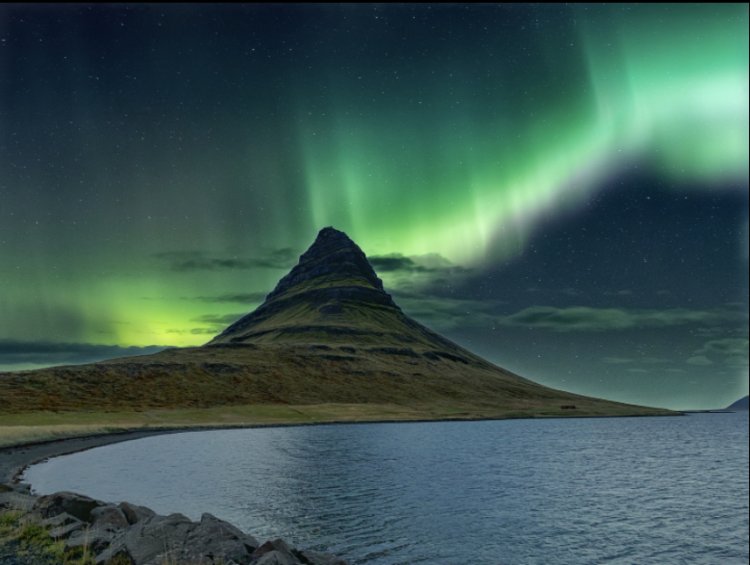Northern Lights, or the Aurora Borealis, is one of those natural phenomena that are likely to be in everyone's bucket list, as it was in mine. With such gorgeous pictures of the green and purple lights in the sky floating around all over social media, how can you not want to see it with your own eyes? It had been more than 3 years since I had been dreaming of visiting a place that'd make a fantastic trip for a nature & adventure lover like me, with the opportunity to see the spectacular light show against magnificent backdrops and that is why I chose Iceland over any other country in the high latitudes to see the Northern Lights. If you're planning a trip to see the Northern Lights in Iceland, you've come to the right place because here is where I help you plan your trip from scratch!
The key to seeing the Northern Lights is to have minimal light pollution in the sky. So, the darker the night, the more likely you are to catch the lights. Having said that, there is a reason why people say that the Northern Lights need to be 'chased'. Planning a trip to see the Northern Lights in Iceland requires consulting a few sources, keeping some important things in mind, selecting the dates of travel and the places you choose to stay, sensibly. A lot of it can be managed with planning but luck surely plays a big part in it.
If you're lucky, you will see the lights even if the prediction for it is low on that day, and in the middle of a city, where light pollution is high. But being prepared didn't harm anyone, so it might be a great idea to keep a few things in mind to increase the probability of seeing the Northern Lights in Iceland.
How to plan a trip to see the Northern Lights in Iceland
When planning a trip to see the Northern Lights in Iceland, there are several tips to follow. As a general rule, the darker the sky, the more visible the lights are likely to be. Keeping this in mind, here's what you can look at:
Pick your months of travel carefully
The best time to see these awe-inspiring dancing streaks of nature's most beautiful performance is between September - April, the reason being that during the autumn/ winter months, the sun sets in Iceland much earlier than it does in the summer, which means darker and longer nights.

However, the winter months between November and March can get extremely cold and the weather can be very unpredictable and unfriendly - it is not uncommon to have strong winds, heavy rains and cloudy, gloomy skies during the winter months. This can mean that not only is exploring most of the country harder during these months, it also becomes quite difficult to get the right kind of weather and skies for a good viewing of the Aurora. This is why I choose September/ October, which is still autumn, with temperatures ranging between a manageable 10 degrees C during the day and 2 degrees at night. Although the weather might be a little unpredictable, you're still likely to find some very clear, sunny days if you travel for 1-2 weeks. And the best part - the prices are lower than in the summer because it isn't the peak season for travel anymore! The sun sets at around 7 pm, which means the skies are extremely dark by 8-9 pm, making it perfect for a great viewing experience of the lights.
Better weather during the autumn months also gives you an opportunity to explore the rest of the country, which you will certainly want to do because watching the Northern Lights cannot be the sole purpose of your trip! Iceland is blessed with rugged, natural beauty and so much to do that one cannot go there and not immerse themselves in the wilderness. Moreover, if the sky is overcast most of the time (which is a possibility during the winter months), even if the Aurora chooses to dance in the skies, you're not going to be able to see it!
Keep an eye out for the moon cycle
Since the sky needs to be dark, it’s most likely that the lights will be visible around the new moon time rather than full moon time. Keeping an eye on the moon cycle and planning a trip around the new moon period can prove to be a great strategy. Not only will you increase your chances of seeing the lights, but you'll also see them with more intensity and clarity than you would on a night with the moon shining bright.
Find a place away from the city lights
Since there is usually light pollution in the cities, the further you go from the city, the higher the chances that you’ll be able to see the lights. Do not hesitate to ask the locals where you can head to, to get the best Northern Lights viewing experience. Wherever you are in Iceland, you can be assured that you will never be too far from a national park or a lighthouse on the coast which will be devoid of any other street light or city light pollution. It may not be a bad idea to rent a car and drive 30 - 40 minutes outside the city to catch a spot by the ocean where it is dark.
Check a reliable website for prediction
Since it is Mother Nature, it cannot be predicted with complete accuracy in advance. However, in the short term, there are some very reliable websites such as these:
Vedur.is for checking the prediction of the Northern Lights. The website not only shows the cloud cover over the entire country but also the possibility of the phenomena taking place, in the next 3 days. This can help you plan where to be (with minimal cloud cover) and on which day to be able to have a fantastic viewing experience. Anything on the scale of 4 and above means a high possibility, as long as you're not under a heavy cloud cover!
Take a Northern Lights tour
If all this planning is not your cup of tea, then simply take a Northern Lights guided tour. If you do not want to rent a car and do it by yourself, be ready to shell out about €80 per head for a 4 hour tour (a small group bus tour) that'll chase the Northern Lights for you. They will take you to the perfect spots, keep an eye out on the predictions and even provide a pick and drop service right to your doorstep. Some Northern Light tours provide a combo option - you could look at doing a glacier hike along with the tour on a different day for example. Most tours, in the event of not being able to spot the lights, will either offer your money back or a backup plan, like use your credit for another activity. You can also choose to do a Northern Lights Boat Tour or a Big Bus Tour! The earlier you book, the better it is, especially on nights when the prediction meter is 4 or more!

It is, perhaps, one of the best decisions I made while travelling to see the Northern Lights in Iceland. Not only does it give you the flexibility to be out and about on the road at any time of the day (rather night), it also gives you the opportunity to be camping under the stars, far away from cities and towns, in the midst of rugged, untamed nature, with front row seats to this phenomenal show. While I was lucky to have seen the Northern Lights right in the middle of downtown Reykjavik, nothing could compare to the experience of watching them somewhere in the middle of nowhere, from the warmth of my campervan, while cooking myself some hot noodles and sipping on a glass of wine. Not only for the purpose of watching the lights but also exploring Iceland in general, renting a campervan is a great idea, if you're open to adventure and don't mind cozy, small places to sleep in.
Spend at least a week
The more time you spend, the higher the probability of seeing the Northern Lights in Iceland. Although the phenomenon might occur a few times during the period you're travelling, you also need to be lucky enough to have clear skies because cloudy skies are likely to spoil the view or block them altogether. I spent about 10 days in Iceland and was extremely lucky to be able to see the lights on 3 of those. Having said that, despite all the calculations and checking predictions beforehand, end of the day, it’s pure luck!
Be prepared to wait
Although the prediction apps will usually tell you to expect the lights to start around a certain time, the Northern Lights can be moody and unpredictable! Sometimes they might appear and stay only for a while whereas other times, they might dance around for hours. On the first night when I saw the lights, they appeared pretty early and quite intensely in the first 15 minutes itself, lasting only for about 45 min in all, fading away after the first few minutes. However, the second time I saw them, I literally had given up on their appearing at all when suddenly, I saw the first green streak almost an hour after waiting for them to appear. On the third day, the lights appeared quite early but were disappointing because they just were not intense enough. But as the time passed, the intensity increased and they stayed for the next 2 hours, brightly green and purple, prancing around teasingly, making everyone freeze in the blistering cold. If the night is clear, which you'll hope for it to be, you're going to need to dress in layers so that the extremely low temperatures are the last thing on your mind while you stand there, with immense patience, to watch this atmospheric spectacle.

I cannot stress on this point enough. Not only did I regret not being able to capture gorgeous pictures of the Northern Lights in Iceland (I deemed my pictures quite average) because my lens wasn't good enough, the truth is, your camera actually gets it better than your naked eye. You'd be surprised to see how much brighter and prettier the lights can look in pictures captured by a good camera than they do in reality to one's eye. Even an iPhone X camera is not able to do justice to it. Of course, you need to know how to use a good camera (consider taking some lessons before you travel) to be able to get the lights because they're not really easy to capture. Oh, and don't forget to carry a tripod along, you're going to want to take long exposure shots.
Nothing I tell you can prepare you for what you'll feel when you do finally see the lights. And although seeing the lights is definitely an experience of a lifetime, don't let it break your heart if you don't. Plan, but don't over-plan. The best thing about heading to Iceland is that even if you're not lucky and aren't able to see Aurora Borealis, there's plenty else to do and see in the country. Some of the most dramatic landscapes, bucolic pastures, spectacular hikes, breathtaking waterfalls, stunning wildlife, tranquil nature walks and incomparable scenery will more than make up for the lack of your luck. Just remember to pack some warm clothes, keep a flexible itinerary and track the prediction apps to successfully experience the Northern Lights in Iceland.























